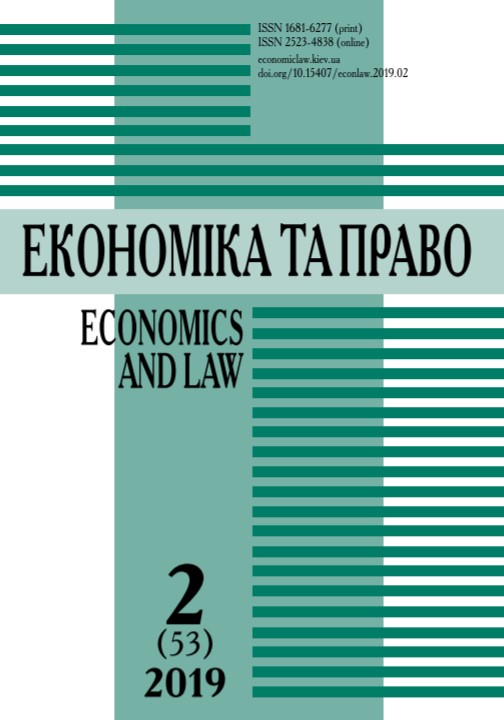ECONOMIC AND LEGAL SUPPORT OF FACTORS DESTABILIZATION ESTABLISHMENT OF FINANCIAL COMPANY CONDITION: TAX ASPECT
Series "Economy": Problems of enterprise management
Abstract
Establishment of the factors destabilizing of enterprise financial condition is a very complex scientific and practical task that requires the use of an interdisciplinary approach, the involvement of specialists in Economics and Law. The article reflects the results of economic and legal support formation and use for establishing the factors of enterprise financial condition destabilization, which affect the non-payment of taxes, in particular value added tax. Economic and legal support in order to identify the factors of the enterprise financial condition destabilization including the economic (horizontal and vertical analysis of the company’s financial report, analysis of receivables and payables, the formula for calculating the adjustment in the Unified Register of Tax Invoices for the amount of tax) and the legal provision (Tax Code of Ukraine, Cabinet Resolution Ministers of Ukraine "Some issues of electronic administration of value added tax", the contracts for the provision of services, the acts of services rendered, the tax invoices, the receipts for the registration of tax invoice for the timing of debt repayment, accounts receivable and payable transactions, a list of completed work with a violation of the calculation period). According to the results of economic and legal support formation and use for establishing the factors of enterprise financial condition destabilization, it was determined that for violation of payment terms by contractors, as evidenced by the chronology of receivables and payables, there was a receivable, which made it impossible to fulfill the obligation of value added tax by the payer. Using of the economic and legal support for establishing the factors of enterprise financial condition destabilization is carried economic and legal support. It is allowed to establish the factors of financial condition destabilization of the real enterprise became the accounts receivable that arose owing to violation of contractual relations and incorrectness of contractual norm on establishment of calculations terms for the provided service.
REFERENCES
1. Moskalenko V.P., Plastun O.L. Kompleksna otsinka finansovoho stanu pidpryiemstva yak osnova diahnostyky yoho bankrutstva. Aktualni problemy ekonomiky. 2006. No. 6. P. 180-192 [in Ukrainian].
2. Poddierohin A.M., Bilyk M.D., Buriak L.D., Bulhakova S.O. ta in. Finansy pidpryiemstv. Za red. A.M. Poddierohina. Kyiv: KNEU, 2006. 552 p. [in Ukrainian].
3. Kindratska H.I., Bilyk M.S., Zahorodnii A.H. Ekonomichnyi analiz: pidruchnyk. Za red. prof. A.H. Zahorodnoho. 3-tie vyd., pererob. i dop. Kyiv: Znannia, 2008. 487 p. [in Ukrainian].
4. Mnykh Ye.V. Ekonomichnyi analiz: pidruchnyk: vyd. 2-he, pererob. ta dop. Kyiv: Tsentr navchalnoi literatury, 2005. 472 p. [in Ukrainian].
5. Varlanov Yu.Yu., Varlanov O.Yu. Modeliuvannia finansovoho stanu pidpryiemstv: sutnisnyi pidkhid do intehrovanoi otsinky. Ekonomichni nauky. 2012. Iss. 59. P. 139-146 [in Ukrainian].
6. Oleksiv I.B., Feshchur R.V. Problemy analizu ta otsinky finansovoho stanu pidpryiemstva. Ekonomichnyi visnyk. 2011. Iss. 68. P. 256-263 [in Ukrainian].
7. Kotenok H.M. Vyiavlennia perevah ta nedolikiv metodiv otsinky finansovoho stanu pidpryiemstva. Nauchno-tekh nycheskyi sbornyk. 2008. No. 23. P. 203-212 [in Ukrainian].
8. Azarova A.O., Ruzakova O.V. Matematychni modeli ta metody otsiniuvannia finansovoho stanu pidpryiemstva. Vinnytsia: VNTU, 2010. 172 p. [in Ukrainian].
9. Pryshva N.Iu., Savchenko L.A. ta in. Naukovo-praktychnyi komentar do Podatkovoho kodeksu Ukrainy. Narodnyi pravovyi portal "Iuryskonsult". URL: http://legalexpert.in.ua/komkodeks/nk/84-nk/2232-22.html [in Ukrainian].
Keywords
factors, destabilization, financial condition, enterprise
Downloads
References
2. Поддєрьогін А.М., Білик М.Д., Буряк Л.Д., Булгакова С.О. та ін. Фінанси підприємств. За ред. А.М. Поддєрьогіна. Київ: КНЕУ, 2006. 552 с.
3. Кіндрацька Г.І., Білик М.С., Загородній А.Г. Економічний аналіз: підручник. За ред. проф. А.Г. Загороднього. 3-тє вид., перероб. і доп. Київ: Знання, 2008. 487 с.
4. Мних Є.В. Економічний аналіз: підручник: вид. 2-ге, перероб. та доп. Київ: Центр навчальної літератури, 2005. 472 с.
5. Варланов Ю.Ю., Варланов О.Ю. Моделювання фінансового стану підприємств: сутнісний підхід до інтегрованої оцінки. Економічні науки. 2012. Вип. 59. С. 139—146.
6. Олексів І.Б., Фещур Р.В. Проблеми аналізу та оцінки фінансового стану підприємства. Економічний вісник. 2011. Вип. 68. С. 256—263.
7. Котенок Г.М. Виявлення переваг та недоліків методів оцінки фінансового стану підприємства. Научно-технический сборник. 2008. № 23. С. 203—212.
8. Азарова А.О., Рузакова О.В. Математичні моделі та методи оцінювання фінансового стану підприємства. Вінниця: ВНТУ, 2010. 172 с.
9. Пришва Н.Ю., Савченко Л.А. та ін. Науково-практичний коментар до Податкового кодексу України. Народний правовий портал «Юрисконсульт». URL: http://legalexpert.in.ua/komkodeks/nk/84-nk/2232-22.html (дата звернення: 15.02.2019).
Abstract views: 290 PDF Downloads: 193









